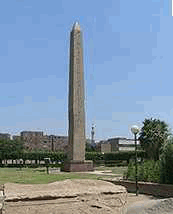
KV16 Like the tomb of Horemheb (KV57), it was decorated with the Book of Gates.
Osiris (oh-SIGH-ris) was the Egyptian god of the afterlife and rebirth. He ruled the netherworld, and his son, Horus, ruled the world of the living. Every reigning pharaoh was identified with Horus and was thought to become one with Osiris after death. At Abydos (ah-BYE-dos or AH-bee-dos), the place most sacred to Osiris, Egyptian kings built temples and funerary chapels so they would be identified with him. They believed that through carved images of themselves their spirits would be able to participate in the annual celebration of the myth of Osiris, during which Osiris was actually reborn, and by extension, they would be reborn as well. Whenever possible, non royal persons also attempted to participate by erecting chapels and stelae at Abydos (slide 33). Originally this limestone relief was on the back wall inside a small chapel built by Seti I for his father, Ramesses I. In inscriptions on the chapel walls Seti declared, “I am the one who makes his name live” and “I will make him a place where his ka [spirit] can alight, drawn in outline and carved with the chisel”
 The scene is divided down the center. On the right Ramesses kneels and presents an offering of food and flowers to a cult symbol of Osiris that resembles a head covered with a cloth or wig and surmounted by two tall ostrich plumes. The symbol is supported by a shaft set into a stand equipped with sledge runners and carrying poles. Encircling the shaft are small figures of deities and the king. Actual cult symbols in the time of Seti and Ramesses were probably made of rich materials. Behind the Osiris symbol is the figure of Isis (EYE-sis), wife of Osiris. She holds an ankh in one hand and raises the other in a gesture of protection.
The poses and arrangement of the figures on the left side of the scene are nearly identical to those on the right. Seti kneels and presents a small kneeling statue of himself offering a jar of myrrh to a cult symbol identical to the one on the right. Behind the symbol stands a falcon-headed figure of Horus, son of Isis and Osiris. He holds an ankh and raises the other hand protectively. The sense of balance is reinforced by the triangular composition.
The scene is divided down the center. On the right Ramesses kneels and presents an offering of food and flowers to a cult symbol of Osiris that resembles a head covered with a cloth or wig and surmounted by two tall ostrich plumes. The symbol is supported by a shaft set into a stand equipped with sledge runners and carrying poles. Encircling the shaft are small figures of deities and the king. Actual cult symbols in the time of Seti and Ramesses were probably made of rich materials. Behind the Osiris symbol is the figure of Isis (EYE-sis), wife of Osiris. She holds an ankh in one hand and raises the other in a gesture of protection.
The poses and arrangement of the figures on the left side of the scene are nearly identical to those on the right. Seti kneels and presents a small kneeling statue of himself offering a jar of myrrh to a cult symbol identical to the one on the right. Behind the symbol stands a falcon-headed figure of Horus, son of Isis and Osiris. He holds an ankh and raises the other hand protectively. The sense of balance is reinforced by the triangular composition.
Reliefs from the two side walls of the chapel are displayed with the central one in the Museum. One shows Ramesses, his face exhibiting signs of old age, receiving offerings of food and drink. In the other, he and his family make offerings to Osiris, Isis, and Hathor.



